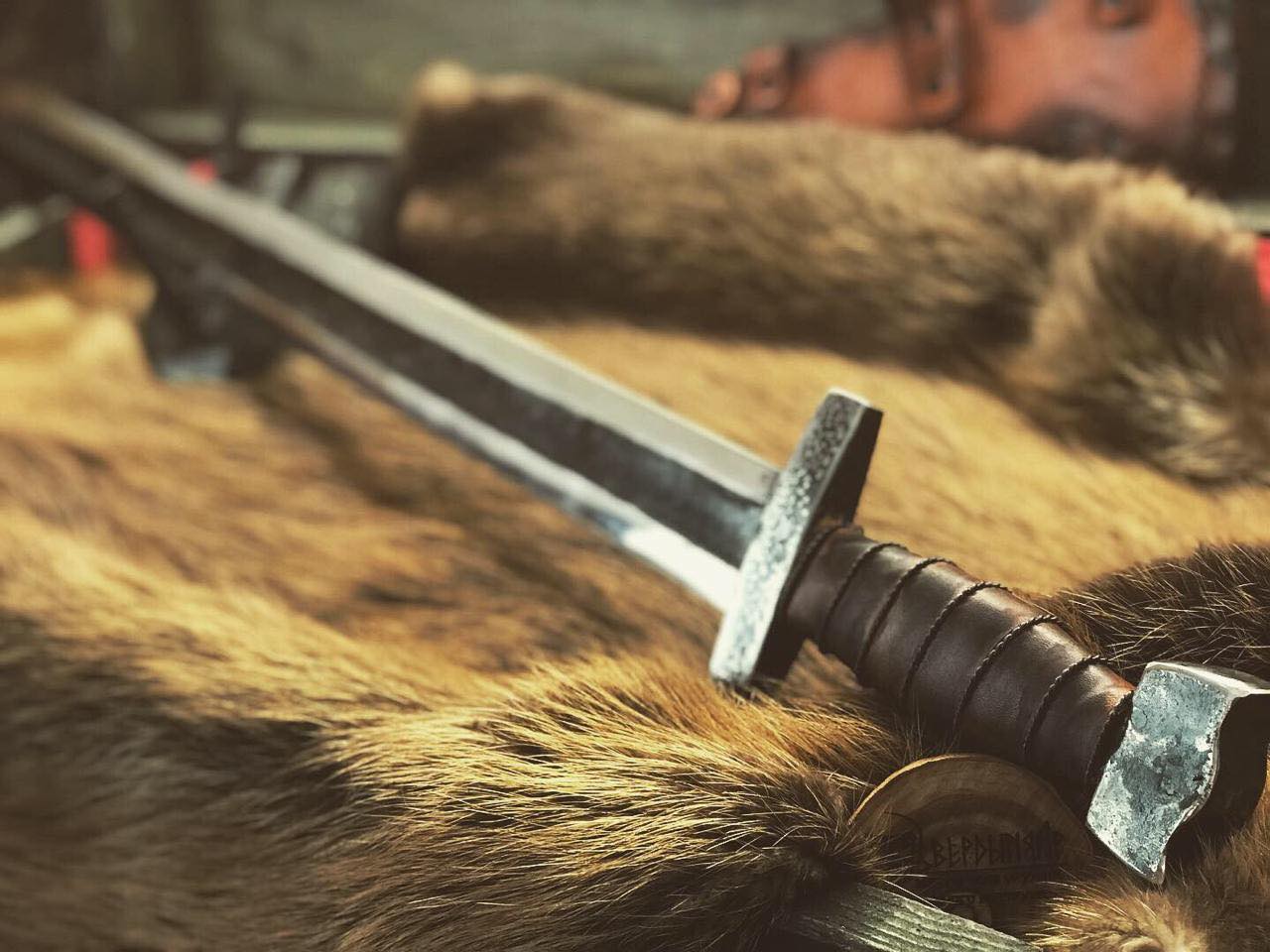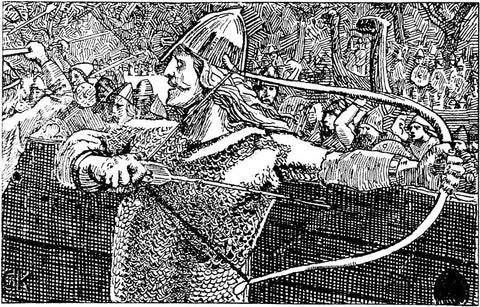on all orders over $100
on all orders over $100

Most of the knowledge about what the Vikings used for weapons came from a few archaeological finds and writings in norse sagas from the 14th century. The Havmal, a Viking book which was said to be the word of Odin, stated that Vikings should carry their weapons at all times since they never knew when they might need them. Below we will cover some of the most common weapons used by the Vikings.
Often viewed as the quintessential Viking weapon, Axes were very popular amongst the norsemen due to the fact that they were readily available and easy to make. Whereas swords were a symbol of prestige and wealth the axe was very much the weapon of choice for the average viking warrior.
Since most of these axes were tools which were used in daily life it would often be the first thing that would be reached for when a fight was imminent. There were however some axes which were specifically design for warfare, and would be carried only by professional soldiers, some of these will be covered in more detail below.

This was an axe design which was thought to have originated in Scandinavia prior to the viking age. This involved an axe head with a longer cutting edge, which extended below the butt of the axe in order to provide the user with extra functionality in battle.
In the hands of a skilled Viking bearded axes had some key advantages over other weapons. The beard could be used to hook weapons or shields, allowing the user to disarm their opponent and create openings which would leave them vulnerable to a fatal blow. Axes were also usually lighter than swords and would allow for more nimble and repeated attacks. The bearded axe design allowed for a longer blade whilst keeping weight to a minimum.
Some of the Viking age axes that were specifically designed for war were very long, which gave the user a greater range of attack. They were fearsome two handed weapons with devastating consequences for anyone who faced off against one in battle.
This design is also commonly referred to as the 'dane axe', and was the weapon used by the famous Viking warrior who single handedly held off an army of English soldiers at the battle of Stamford Bridge. It was said that he cut down more than 40 enemies before he was finally killed by a spear wound from beneath the bridge.
Contrary to popular belief swords, not axes, were actually the most sought after weapons for Viking warriors. The problem was that swords were very expensive and difficult to make, therefore only Viking nobles or professional soldiers would be able to afford them. It was often the case that a sword would be the most expensive thing that a Viking owned and they would be passed down through families.
A number of Viking swords have been found at historical sites throughout Scandinavia and the United Kingdom. They are usually double edged and around 90cm long, designed to be wielded in one hand in conjunction with a shield. This design was fairly typical across europe during the Viking age.
Many of the swords that the early Viking age Scandinavians found in their possession came from the neighbouring kingdoms and were acquired through trade or pillaging. In fact the majority of Frankish made swords were actually found in Scandinavian burial sites due to the scale of their importation.
There have been some theories by modern historians that the Vikings may have unknowingly created an early form of steel by using the bones of their ancestors to empower their weapons.
Since carbon is present in all lifeforms it is thought that the Vikings may have burned the remains of their loved ones and used this in the forging process. This idea is supported by the fact that both human and animal bones have been found at historical blacksmithing sites throughout Scandinavia. The process of forging swords from bog iron, which is the cheap iron that Viking age Scandinavians most commonly used, and carbonated remains has been replicated in modern times and showed to significantly increase the the durability of the metal.
Spears were also a common weapon throughout europe during the Viking age. They were easy to make and cheap due to the fact that they used much less iron than other weapons. Forging a spearhead was also considerable easier than forging a high quality sword. Viking age spears were usually made from 4 -10 feet in length, depending on their intended use.
Some disadvantages of spears were that they were more easily damaged in battle than swords and could be broken by repeated blows to the shaft. They were also more cumbersome than swords or axes, and less advantageous for use on horseback. Changing sides with a spear by lifting it over the horses head was much more difficult that performing the same manoeuvre with a sword and would require much more skill. However it was not common for Vikings to fight on horseback as they usually preferred close hand to hand combat over cavalry charges.
This was a very effective weapon which could be used with a shield and provided good defence against a variety of opponents, it could be thrust or thrown at an enemy. There was also an extra advantage that a spear had a longer reach than most other close combat weapons, meaning one could keep a distance until the spear was either broken or thrown, and then draw a sword or axe to continue fighting.
The learning curve for fighting with a spear was considered to be much shorter than that of a sword. The spear and shield combination would have been ideal for the famous Viking shield wall formation, which would have allowed them to lock shields and thrust their spears over the top.
When facing cavalry in combat it would have been customary to use longer spears, whereas shorter ones would have been more useful in hand to hand combat. These would generally be used in both hands as they would have been too long to control with just one.
The two handed spear could also be used in the shield wall formation, where one soldier would be armed with a shield and sword or axe, and another would stand behind him with the two handed spear. The spear could then be thrust over the shoulder of the shield-bearer, allowing for a deadly combination of both defence and offence.

Custom Viking Spear Head
The word 'Seax' itself is an Old English translation for the modern word for 'Knife', back in Middle Ages this was a catch all term for a bladed weapon, and there have been many different designs referred to by this name. In the modern context this word is used to describe this particular design of knives, swords and daggers that were traditional to the Germanic Tribes of the migration period and Middle Ages.
The Seax was a single edged knife which was a traditional design in Viking age Scandinavia and was also commonly used by many other Germanic peoples. There have been many Viking historical sites where blades of various sizes and lengths have been found. During the viking age the Seax was usually carried with a sideways sheath with the blade facing upwards, this allowed for easy access.
This would have been an ideal secondary or tertiary weapon that could be drawn for in a battle if in a close combat situation or In addition to being a weapon of war and an essential side arm, the Seax was also an essential tool in everyday life for people in the Viking age.
The bow and arrow was the pinicle of military technology in medieval Europe. It allowed long range attacks on the enemy forces to pick them off before they got in range for hand to hand combat. Viking archers had a different approach to many other Europeans at the time. It was often considered to be the weapon of poor or low ranking warriors, since it was cheap, easy to use and not very glorious, however in Viking sagas there are various mentions of noblemen using bows.
The Vikings would often rain arrows down upon the enemy from behind their shieldwall formation. There are also accounts of members of Viking armies who would stay near the edge of a battle and use their skills with a bow to pick off enemy soldiers.

Einar Thambarskelfir tries the king's bow and finds it too weak - Christian Krogh
Check out our armoury for some handmade Viking Weapons.
Leave a comment